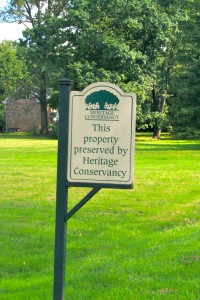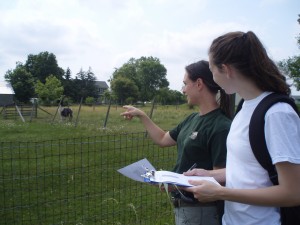 More times than not, when we ask people in the community how they heard about us, often the answer is, “I drove past one of your signs.” Our large signs with dark green print and a large oak tree logo are scattered among miles of rolling hills, agricultural fields, natural wetlands and forests across Pennsylvania and New Jersey. And they all say the same thing: “This property preserved by Heritage Conservancy.” Simple enough, right? Maybe not. Passersby typically appreciate the picturesque beauty and serenity of these preserved properties but very often have little understanding of the process that Heritage Conservancy and the property owner must go through in order to stake one of those signs into the ground.
More times than not, when we ask people in the community how they heard about us, often the answer is, “I drove past one of your signs.” Our large signs with dark green print and a large oak tree logo are scattered among miles of rolling hills, agricultural fields, natural wetlands and forests across Pennsylvania and New Jersey. And they all say the same thing: “This property preserved by Heritage Conservancy.” Simple enough, right? Maybe not. Passersby typically appreciate the picturesque beauty and serenity of these preserved properties but very often have little understanding of the process that Heritage Conservancy and the property owner must go through in order to stake one of those signs into the ground.
As an accredited not-for-profit conservation organization with over fifty years of experience… allow us to explain!
There are many steps to preserving a property. One of the basic ways is to place a conservation easement on a property. It protects the property, but allows landowners to continue to own and use their land or pass it on to heirs. Heritage Conservancy assists landowners through this process. This includes thoroughly explaining what the landowner can expect to happen throughout the preservation process. We explain the general restrictions of a typical conservation easement and the potential tax benefits associated with donating the full or partial value of a conservation easement. We always recommend that a landowner seek professional tax advice if they choose to complete a bargain sale or full donation of the conservation easement.
Next steps include a site visit to evaluate the property’s conservation values such as natural areas like wetlands, creeks or woodlands, agricultural lands, scenic views, or other public benefits, such as trails. These are the conservation values that will be protected through the easement agreement. If a landowner is seeking public funding, these conservation values will assist in determining which land preservation funding programs are the best fit for the property. We often assist the landowner in determining what funding programs are available to fund the easement and work on behalf of the landowner in writing and presenting the grant requests to the various funding programs.
Appraisals that determine the value of the conservation easement and a survey of the property are also required as part of the preservation process. We also assist the landowner in finding professionals to complete these tasks and potentially find funding to help pay for these project costs.
After the property’s conservation values have been determined and appraisals completed, and once grant funding has been approved, Heritage Conservancy assists in the negotiations of the terms in the conservation easement document. We explain in great detail what the landowner can and cannot do on their property as a result of the conservation easement. We act as an intermediary between the grant funder and the landowner until all parties mutually agree with the terms of the easement. In all cases we recommend that a landowner hire an attorney to work on his or her behalf.
Once the terms of the easement have been negotiated, the survey completed, title report ordered and reviewed, a baseline documentation is completed on the property. A baseline documentation is a written inventory of the property’s natural resources and is needed to ensure the property is in accordance with the conservation easement prior to settlement and is also needed for future monitoring.
If no issues are found during the baseline site visit, final conservation easement and baseline documents are prepared for settlement, which is similar to the settlement property owners go through when selling a home. Heritage Conservancy coordinates a settlement time and place with the landowner, landowner’s attorney, title company and grant funding program staff, if public funding was part of the process.
Once settlement has occurred and a property is preserved, our professional staff visits the property at least once a year to monitor its consistency with the conservation easement. Typically, when public funds are involved, the process of preserving a property can take about two years. So the next time you drive by one of our preserved property signs, as you catch a glimpse of the lovely, natural scenery, you will have a better understanding of the landowner’s dedication to this process and the commitment of Heritage Conservancy to protect that property forever, so that the community may enjoy the same natural beauty for generations to come.
If you’re interested in learning more about preserving your property, contact Laura Baird, Senior Land Conservationist at (215) 345-7020 x 135.
